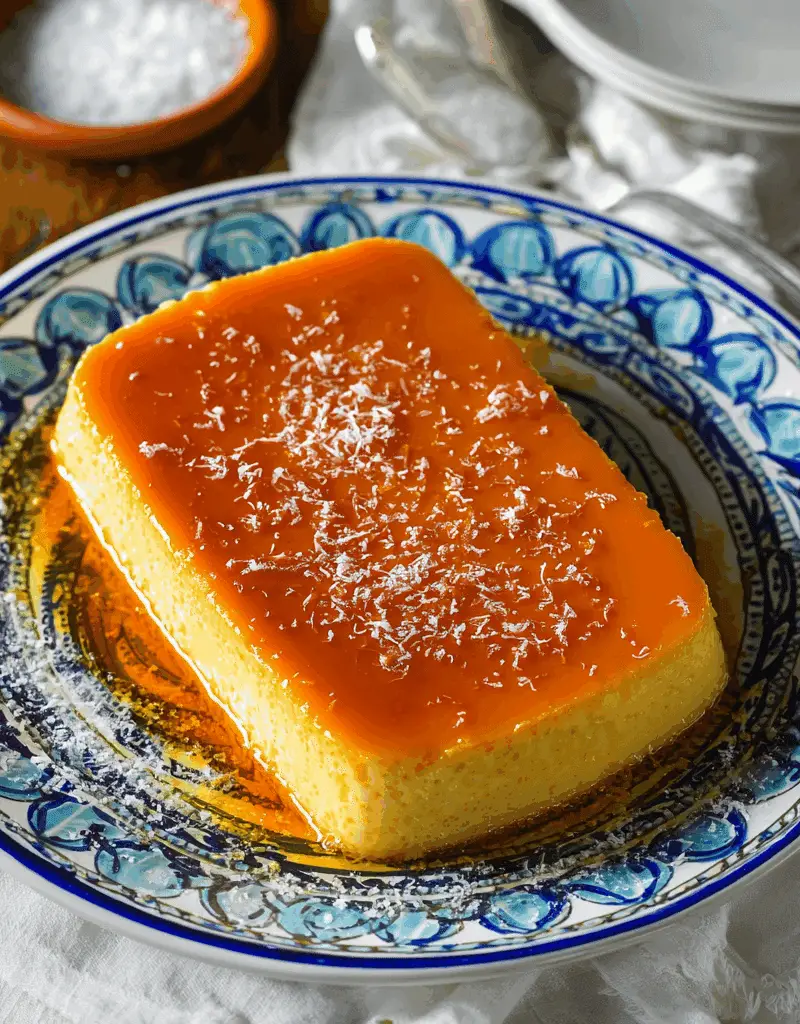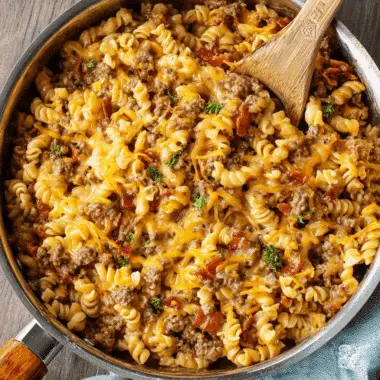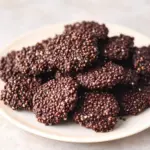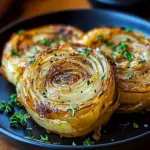The French Antilles Coconut Flan, also known as “Flan Coco”, is a beloved dessert from the Caribbean islands of Guadeloupe and Martinique. Its rich coconut flavor and creamy, custard-like texture offer a sweet taste of island life, while the caramel topping adds a luxurious finish.
This flan is simple to make yet delivers a show-stopping result. Whether you’re reminiscing about a Caribbean vacation or bringing the flavors of the tropics to your kitchen for the first time, this coconut custard is a delightful dessert for any occasion. Serve it chilled and let the golden caramel cascade over each slice—it’s a treat that will impress every guest at your table.
Full Recipe
Ingredients:
-
1 cup granulated sugar (for caramel)
-
1 can (13.5 oz) full-fat coconut milk
-
1 can (14 oz) sweetened condensed milk
-
1/2 cup whole milk
-
3 large eggs
-
2 large egg yolks
-
1 tsp pure vanilla extract
-
Pinch of salt
Directions:
-
Preheat your oven to 325°F (160°C).
-
In a medium saucepan, melt the granulated sugar over medium heat until it turns a deep golden caramel. Swirl the pan gently for even coloring—do not stir.
-
Quickly pour the hot caramel into a 9-inch round cake pan or individual ramekins. Tilt the pan to coat the bottom evenly. Set aside to harden.
-
In a large mixing bowl, whisk together the coconut milk, sweetened condensed milk, whole milk, eggs, egg yolks, vanilla extract, and salt until smooth and fully combined.
-
Carefully pour the mixture over the hardened caramel in the pan.
-
Place the flan pan inside a larger baking dish and fill the outer dish with hot water until it reaches halfway up the sides of the flan pan (creating a water bath).
-
Bake for 50-60 minutes, or until the center is just set and slightly wobbly.
-
Remove from the oven, carefully lift the flan pan out of the water bath, and let cool to room temperature.
-
Refrigerate for at least 4 hours or overnight.
-
To serve, run a knife around the edge of the flan, invert onto a serving plate, and let the caramel drizzle over the top.
Prep Time: 20 minutes | Cooking Time: 55 minutes | Total Time: 1 hour 15 minutes
Kcal: 295 kcal | Servings: 8 servings
Origins of Coconut Flan from the French Antilles
Coconut Flan, or Flan Coco, is a signature dessert from the French Antilles—a group of islands in the Caribbean including Guadeloupe and Martinique. These islands are part of France’s overseas territories, and their cuisine is a vibrant fusion of French culinary techniques and tropical Caribbean flavors. The flan is deeply rooted in both cultures: it embodies the French love for custards and creams, while celebrating the abundant tropical ingredients native to the Caribbean, most notably coconut.
The historical roots of this dessert date back to colonial times, when French settlers brought with them traditional European custard recipes. Over time, these were adapted to local ingredients and influenced by Afro-Caribbean culinary traditions. Coconuts, which grow in abundance on the islands, became a natural substitution and enhancement, replacing some dairy elements and offering a rich, creamy flavor with a distinct island personality.
Why Coconut Flan is Beloved in the French Caribbean
The appeal of Coconut Flan lies in its unique balance of textures and flavors. It’s ultra-creamy but light, sweet without being overpowering, and topped with a luscious layer of golden caramel that melts into the custard with each bite. For islanders, it represents comfort, celebration, and the shared joy of good food. It’s often served at family gatherings, Sunday meals, holidays, and special occasions.
This dessert reflects the slow, intentional pace of Caribbean life. It takes time to prepare and chill, and is best enjoyed slowly, preferably outdoors with the sounds of nature or music nearby. It also represents the creativity of Caribbean home cooks who learned to use whatever they had—fresh coconuts, eggs, and sugar—to transform simple ingredients into something spectacular.
Cultural Significance and Modern Popularity
In the French Antilles, food is more than sustenance—it’s a story, a ritual, and a means of preserving identity. Coconut Flan is often passed down through generations, with families adding their own variations: a dash of lime zest, a splash of rum, or a slightly firmer texture depending on preference.
Today, Coconut Flan has gained international recognition. Food bloggers, chefs, and travel enthusiasts have fallen in love with its rich taste and visual elegance. It’s become a staple in Caribbean-themed menus and fusion restaurants around the world. Its ingredients are accessible, and its execution is simple enough for beginners while rewarding enough for seasoned bakers.
How Coconut Flan Stands Out From Other Flans
While flan is enjoyed globally—in Latin America, Spain, and Portugal—what sets this version apart is the use of full-fat coconut milk and the deeper tropical dimension it adds to the custard base. Most traditional flans rely heavily on dairy milk or cream, but in Flan Coco, coconut milk is the star. This substitution brings a mild sweetness and a creamy density that transforms the dessert into something indulgently exotic.
In addition to the coconut flavor, the texture is typically denser and silkier, a result of using both whole eggs and yolks. The caramel layer, prepared by gently melting sugar until golden, forms a glistening glaze that adds both sweetness and visual appeal. The flan is often inverted onto a plate for serving, showcasing the caramel top in all its glossy, golden beauty.
Tips for Perfecting This Island Dessert
The beauty of Coconut Flan lies in its simplicity, but there are a few tips that elevate it to perfection:
-
Use full-fat coconut milk for richness and flavor depth. Light versions won’t provide the same creamy mouthfeel.
-
Strain the custard mixture before baking to ensure a smooth, lump-free texture.
-
Create a gentle water bath during baking to prevent curdling and ensure even cooking.
-
Chill the flan thoroughly before serving—it improves both texture and flavor.
-
Invert carefully—this step reveals the stunning caramel layer and completes the presentation.
These subtle techniques make a huge difference in creating a silky, balanced, and visually striking dessert.
Serving Suggestions and Pairings
Coconut Flan is best served chilled, often with nothing more than a spoon and a smile. However, it can also be dressed up depending on the occasion. A few serving ideas include:
-
Topping with fresh mango or pineapple slices for added tropical flair
-
Garnishing with toasted coconut flakes for crunch and aroma
-
Serving alongside a shot of Caribbean rum or espresso
-
Pairing with a light fruit sorbet to contrast the creamy texture
-
Dusting with a pinch of fresh nutmeg or lime zest for extra brightness
Whether served as-is or with gourmet additions, Coconut Flan always manages to feel both indulgent and refreshing.
Storage and Make-Ahead Tips
This dessert is ideal for entertaining because it must be made ahead. It requires chilling for several hours—ideally overnight—which allows the custard to set properly and the caramel to infuse the flan with flavor.
Coconut Flan stores beautifully in the refrigerator for up to 3 days. Be sure to cover it tightly to prevent it from absorbing other odors. It should never be frozen, as the texture will break and become watery once thawed.
If you’re planning a dinner party or celebration, prepare the flan a day in advance and simply invert it onto a serving platter when ready to enjoy. It’s a no-stress, showstopper dessert.
Variations and Creative Twists
While the traditional recipe is delicious on its own, many cooks enjoy adding their own flair. Here are a few common variations:
-
Rum-Infused Flan Coco: Add a tablespoon of dark Caribbean rum to the custard mixture.
-
Citrus Coconut Flan: Include zest from lime or orange to brighten the flavor.
-
Spiced Coconut Flan: Add a dash of cinnamon or nutmeg for a warm, comforting twist.
-
Chocolate Coconut Flan: Swirl in a bit of melted dark chocolate to make it even more decadent.
-
Vegan Flan Coco: Use coconut cream, plant-based condensed milk, and cornstarch instead of eggs.
These variations allow the flan to be adapted for different palates and dietary needs while maintaining its tropical roots.
Coconut Flan’s Role in French Antillean Identity
In many ways, Flan Coco is more than dessert—it’s a symbol of island pride. It encapsulates how French and Caribbean cultures can blend harmoniously. It tells a story of colonization, adaptation, and resilience, transformed into something sweet, tangible, and joyous.
When shared at gatherings, it becomes a memory-making dish—a way to celebrate culture, family, and heritage. For those from the French Antilles living abroad, it’s also a powerful reminder of home and identity.
Conclusion: Why You Should Make This Coconut Flan Today
Coconut Flan from the French Antilles is one of those rare desserts that’s both simple and sophisticated. It doesn’t require fancy equipment or hard-to-find ingredients, yet it delivers an unforgettable flavor experience. The velvety texture, rich coconut taste, and golden caramel topping make each bite a small escape to the tropics.
Whether you’re a seasoned baker looking for something new or a novice cook curious about global cuisine, this dish will exceed expectations. It’s versatile, beautiful, and steeped in cultural meaning. Most importantly, it brings people together—around the table, across cultures, and through generations.
Add this flan to your repertoire and you won’t just be making dessert—you’ll be serving a taste of the Caribbean’s heart and soul.








